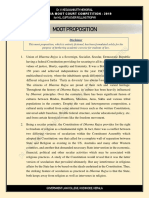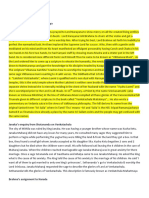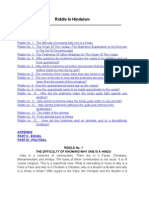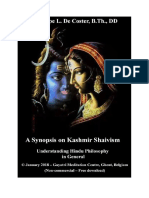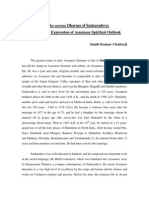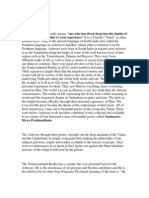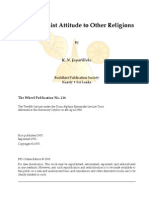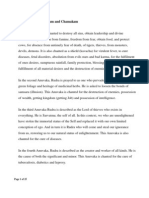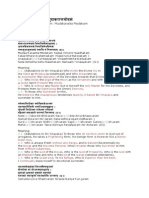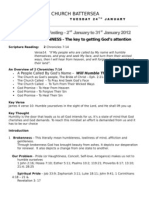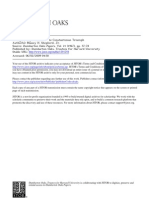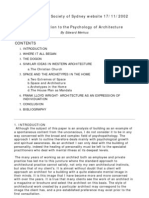STATEMENT OF FACTS
Union of Brahma Puri is a Sovereign, Socialist, Secular, Democratic Republic with a federal
Constitution committed to securing justice, liberty, equality, and fraternity for all its citizens.
Formerly a British colony for around 150 years, Brahma Puri achieved independence in 1947.
This multicultural society boasts a rich tapestry of languages and religious practices, with “Unity
in Diversity” as the national motto. The citizens take pride in their heritage, significantly
influenced by Dharmic principles throughout history. Over centuries, the cultures of Hindus,
Buddhists, Muslims, Jains, Sikhs, and various tribal populations have fused, resulting in cultural
unity, reinforced by the written Constitution, universal adult franchise, a flexible federal
structure, and secular educational policies, alongside historical events such as the freedom
movement.
As a secular nation, the Constitution of Brahma Puri enshrines the right to freedom of religion as
a fundamental right. During the drafting of the Constitution, a conflict emerged between two
versions of secularism: one advocating for a complete separation of state and religion, similar to
the US and Australia, and another supporting state intervention in religious practices' economic,
financial, and political aspects. The latter version prevailed, allowing state intervention based on
constitutional ideals. Consequently, Brahma Puri's secularism involves the state both maintaining
a distance from and intervening in religious matters.
State of Amarnad, one of the states in Brahma Puri located on the southwestern coast, constitutes
only about one percent of the country’s total area. It can be divided into three distinct climatic
regions: the eastern highlands, central mid-lands, and western lowlands. Despite being isolated
by a mountainous belt, Amarnad is densely populated. According to the 2011 Census, 54.73% of
Amarnad’s population are Hindus, 26.56% Muslims, 18.38% Christians, and the remaining
0.33% follow other religions or no religion. The state has a unique culture, with a diverse
religious tradition and its own language. In the nineteenth century, Amarnad experienced a
cultural and ideological struggle against traditional cultural elements and upper-caste Hindu
hegemony. This was due to societal structural changes and the emergence of an educated middle
class, leading to movements for social and religious reform, including caste reform or abolition,
women's equal rights, campaigns against child marriage, and the removal of bans on widow
�remarriage. These renaissance movements emphasized social justice, gender equality, and
individual liberty.
Amarnad, known as God's own country, is home to many ancient temples, including the famous
Brahmagiri Temple or Temple of Sri Brahmamurthi. Situated atop a dense forest-covered hill at
an altitude of about 900 meters, this temple was constructed by King Pandian of the
Brahmamangalam dynasty between the 11th and 12th centuries AD. Initially managed by the
Brahmamangalam Royal Family, its administration was taken over by the British Government
post-invasion of Amarnad. After independence, the temple's management was vested in the
Brahmagiri Temple Administration Committee (BTAC), an autonomous body incorporated under
the Amarnad Hindu Religious Institutions Act, 1950. The BTAC has the authority to direct,
control, and supervise the temple, ensuring its administration aligns with temple customs and
usage. The committee's Commissioner and authorized persons can enter the temple premises for
administration purposes, with reports submitted to the state government quarterly. The Chief
Priest's family retains the privilege of deciding on essential religious practices. Temple income is
absorbed into the state's general revenues, with maintenance expenses covered by the state. The
BTAC’s accounts are audited by auditors designated by the High Court of Amarnad.
The Sri Brahmamurthi Temple is unique, with arches, courtyards, doorways, and guardian god
images but no deity. An empty throne inside the Garbhagriha or Sanctum Sanctorum symbolizes
the spiritual presence of the invisible God Sri Brahmamurthi. Despite a long 10 km trek to the
temple, thousands of pilgrims, called ‘brahma margis,’ make the journey annually. The entry
and exit doors of the shrine are known as ‘Swarga Dwar’ (door to heaven) and ‘Moksha Dwar’
(door to liberation), respectively. Next to the temple, at a level about 20 meters lower, lies
Brahma Sarovar, an oval-shaped natural lake about 12 acres in area and 15 meters deep,
bounded by steep mountains. The lake has 108 holy steps leading to Swarga Dwar. In yoga, the
number 108 signifies spiritual completion.
The blessed water of Brahma Sarovar is believed to possess miraculous powers. Ritual
immersion in the lake symbolizes a change of soul, ritually cleansing a person from past deeds
and leading to cosmic salvation. In Hinduism, utmost purity (suddha sattva) is considered the
essential nature of a human being, with impurity viewed as a temporary condition that can be
�overcome with effort. Scriptures suggest various purification methods, including ritual
immersion in Brahma Sarovar. Devotees, after immersing themselves in the lake, pray for the
release of negative energy and spiritual support to raise their vibration, viewing the ritual bath as
a spiritual rebirth. Those who bathe in Brahma Sarovar and offer prayers at the temple by
climbing the 108 holy steps are believed to achieve Moksha, a state of eternal purity.
The Brahmagiri pilgrimage has five stages: taking a vow of self-discipline for 28 days, traveling
to the pilgrimage site, performing the ritual bath wearing only a loincloth, ascending the 108
sacred steps to the shrine, and the return journey with a pure mind and body. This pilgrimage
fosters a new community of ‘brahma margis,’ transcending caste, class, and other hierarchies to
assume an egalitarian identity. Although the pilgrims fall broadly within Hinduism, males of all
ages participate equally, regardless of caste, creed, or religion. However, the pilgrimage is male-
centric, excluding women and girls. This exclusion is justified by two streams of reasoning:
menstruation is considered impure, preventing women from attaining eternal purity, and
women's physical weakness necessitates protective discrimination. Although there was no formal
prohibition on women's entry in the past, other non-religious factors like the arduous pilgrimage
and drowning risks deterred them. The Brahmagiri Temple Administration Committee
formalized the exclusion in a Notification dated October 12, 1955, maintaining the temple's
purity and holiness by barring those who hadn't observed the usual vows and women, including
girls, from entering the temple. This notification forms the legal basis for the ban, upheld by the
High Court of Amarnad in 1991.
The present writ petition, a Public Interest Litigation (PIL) filed before the Supreme Court of
Brahma Puri by the Brahma Puri Association for Trans Equality (BPATE), challenges the
constitutional validity of the 1955 Notification. The petition arose from an incident involving
Riyan, is a genetic male whose visible sexual parts are those of a woman. He has female external
genitalia, but lacks such internal organs as ovaries and fallopian tubes. Instead, he has certain
male internal organs, like seminal vesicles, as well as testes hidden up in the body. It has been
medically certified that he will have no menstruation and has no procreative capability. Riyan is
an Afghan citizen. Aged 34, Riyan, born to Muslim parents, developed a spiritual inclination
towards Hinduism, believing in the spiritual cleansing ritual of Brahmagiri. Medically certified
as having no menstruation and no procreative capability, Riyan, accompanied by two Indian
�male friends, was prevented by police from entering the temple on October 18, 2018, despite
asserting his male gender identity, adherence to the required vow, and belief in spiritual
salvation.
BPATE filed the PIL, seeking a Writ of Mandamus to ensure all human beings, including female
devotees and transgender individuals, are permitted to enter Brahmagiri Temple without
restriction. The Chief Justice of Brahma Puri has constituted a Five-Judge Bench for the final
hearing. On September 28, 2019, a 4:1 majority of the Supreme Court held that the Brahmagiri
Temple’s exclusionary custom is unconstitutional. More than 50 review petitions were
subsequently filed by various individuals and organisations. The Supreme Court began
hearing the review petitions in open court on the following issues.
● Whether the Review petition filed before this Hon’ble Supreme Court is maintainable?
● Whether a person not belonging to a religious denomination or religious group can
question a practice of that religious denomination or religious group by filing a PIL?
● Whether the notification issued on 12.10.1955 is violative of Part III of the Constitution?
● Whether the classification based on the biological features is violative of the religious
rights of the women?
● Whether the rights of a religious denomination under Article 26 of the Constitution of
India are subject to other provisions of Part III of the Constitution of India apart from
public order, morality and health?
❖ The Constitution and all other laws of Brahma Puri should be interpreted in pari materia
with the Constitution and other laws of India with the limited exceptions herein
mentioned.
❖ The judicial precedents of the Supreme Court and High Courts of India have the same
binding force in Brahma Puri as they would have in India.
❖ The position of the State of Amarnad in Brahma Puri is the same as that of Kerala in
India.
